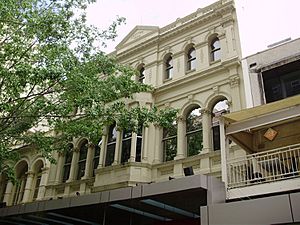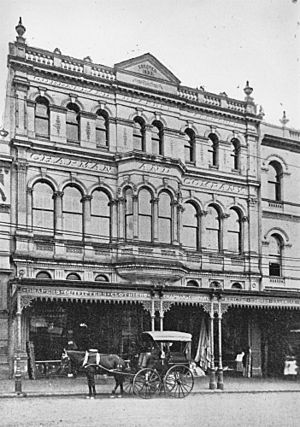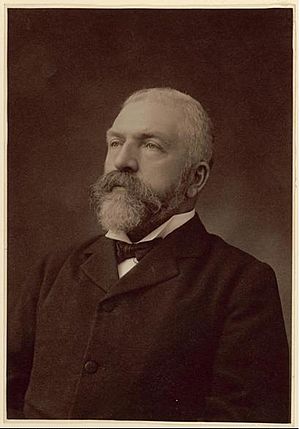Edwards and Chapman Building facts for kids
Quick facts for kids Edwards and Chapman Building |
|
|---|---|

Upper facade, former Edwards and Chapman Building, 2009
|
|
| Location | 120 Queen Street, Brisbane City, City of Brisbane, Queensland, Australia |
| Design period | 1870s–1890s (late 19th century) |
| Built | 1881–1882 |
| Built for | Richard Edwards and James Chapman |
| Architect | Francis Drummond Greville Stanley |
| Architectural style(s) | Italianate |
| Official name: Sportsgirl, Edwards and Chapman | |
| Type | state heritage (built) |
| Designated | 21 October 1992 |
| Reference no. | 600139 |
| Significant period | 1881–1923 (fabric) 1882–1938 (historical) |
| Builders | Henry Holmes |
| Lua error in Module:Location_map at line 420: attempt to index field 'wikibase' (a nil value). | |
The Edwards and Chapman Building is a special old building in Brisbane City, Queensland, Australia. It's located at 120 Queen Street. This building used to be a shop and a storage place.
A famous architect named Francis Drummond Greville Stanley designed it. Henry Holmes built it between 1881 and 1882. Because of its history and design, it was added to the Queensland Heritage Register on October 21, 1992.
Contents
A Look at the Building's Past
This building was finished in 1882. A company called Edwards and Chapman moved in during December of that year.
Who Were Edwards and Chapman?
In 1877, a businessman from Wales named Richard Edwards teamed up with James Chapman from Scotland. They started a fabric and clothing store in Brisbane. Their business did very well!
So, in September 1881, they bought the land where the building now stands. Before this building, an old convict barracks stood here from 1827. It was later used as the first parliament house and supreme court. This old building was taken down in early 1881.
Building a New Store
Francis D. G. Stanley, who used to be the Colonial Architect, oversaw the building's construction. Henry Holmes was the main builder.
The building was quite large, with a front facing Queen Street that was about 14.6 metres (48 feet) wide. It went back about 42 metres (138 feet). It had three floors and a basement. The designers added special features to help with Brisbane's warm weather. For example, the ceilings were very high, about 5.5 metres (18 feet). Also, there was a large oval opening on each floor. This helped air move around and let more light in. The building even had an early Otis lift that used water power!
Changes Over Time
Richard Edwards retired in 1891, and the company changed. James Chapman became the sole owner. The business, now called Chapman and Company, started selling home furnishings and furniture.
In 1923, the shopfronts were updated by S. S. Carrick, with help from the architects Hall and Prentice. This work involved adding strong steel supports to the building.
Chapmans sold the building in 1938, after being there for 56 years. Since then, many different shops have used the building. In 1992, when it was listed as a heritage site, a women's clothing store called Sportsgirl was there. Today, a fashion retailer called City Beach uses the top three floors.
What Does the Building Look Like?
The Edwards and Chapman Building is from the Victorian era. It was designed by F. D. G. Stanley with fancy Italianate details.
It has three main floors, a basement, and an attic. The back and side walls are made of brick. The front, facing Queen Street, is very decorated. The back uses bricks of different colours. The front uses light-coloured Oamaru limestone.
Street Level and Upper Floors
At street level, the building now has a modern shop front. There's a main entrance in the middle, with shop windows on either side. A roof-like structure called an awning hangs above.
The first floor has a window that sticks out, called a bay window or oriel window. On either side of it are arches. The original bay window has been replaced with a modern glass one. The arches are round and are supported by columns called pilasters with fancy Corinthian tops. Behind these arches are large glass windows.
The second floor has round windows that line up with the arches below. These windows have decorative carvings above them and prominent keystones shaped like acanthus leaves. The front of the building, called the facade, has a decorative band with small blocks. This band forms the base of a Corinthian entablature with Italianate balustrading. At each end, there's a vase on a stand. In the centre, above the roofline, is a triangular shape called a pediment. It has the words "ERECTED 1882" carved into it.
Inside and Back of the Building
The inside of the building has changed a lot over the years. However, some parts of the original decorated columns can still be seen.
The back of the building, made of different coloured bricks, has a carefully designed look with arched openings. The stone base is partly visible. Not much has changed on this side since it was built. Some openings have been bricked up, and modern doors have been added for access from Burnett Lane.
This building is part of a group of old Victorian-era commercial buildings. They stand out on Queen Street and show what the area looked like long ago.
Why is it a Heritage Site?
The Edwards and Chapman Building was added to the Queensland Heritage Register on October 21, 1992, for a few important reasons:
- Showing Queensland's History: The building helps us understand how Queensland's history unfolded. It shows the second big phase of development on Queen Street in the early 1880s. This happened after the old convict barracks were removed.
- Showing a Special Design Style: It's a great example of the commercial buildings designed by Brisbane architect F. D. G. Stanley. It also clearly shows the fancy Italianate style of commercial buildings from the Victorian era.
- Its Beautiful Look: The building is important because of its beautiful design. It adds a lot to the look of Queen Street, especially as part of a group of other surviving buildings from the 1880s.
Images for kids






